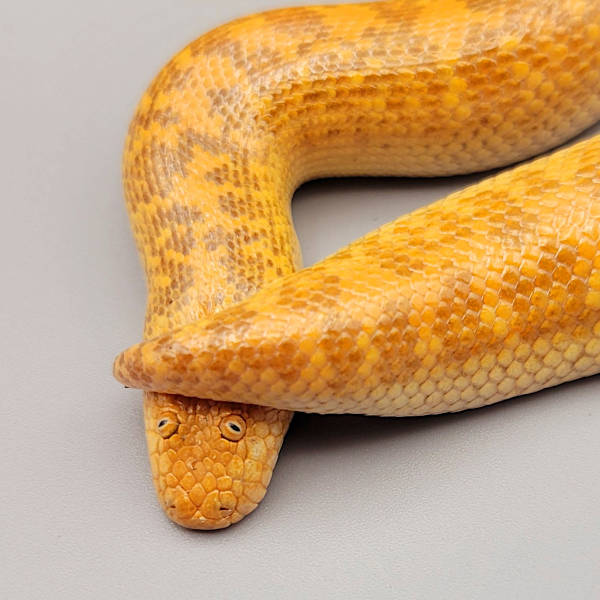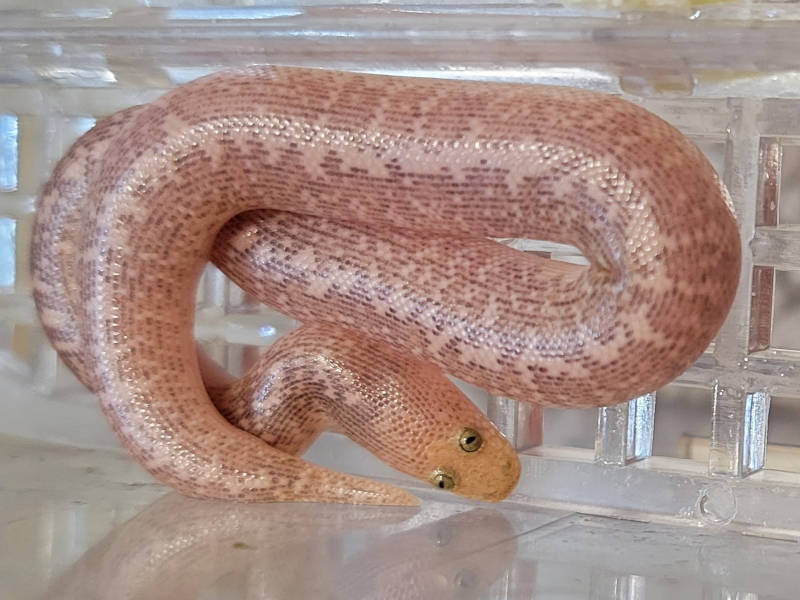Arabian Sand Boa

Eyes of E. jayakari.
Frequently Asked Questions
There seems to be a high degree of interest in Arabians, as I receive a large volume of questions about the availability of this unique species. In an effort to share answers to some of the more common questions, I’ve listed them below.
When will you have babies available?
I will not have babies available to the general public for the foreseeable future. My last reproductive female passed away in 2022, however, I am raising some of her offspring. Hopefully, there may be a chance to produce some clutches once they mature. This may be by 2025 or later.
Can I be added to a waitlist?
I do not plan to add anyone to a waitlist until reproduction is more predictable. However, for potential updates on this project, sign up for our quarterly newsletter.
What is their price?
There is no market price since trade of this species is almost nonexistent, due to scarcity. If someone tries to sell you an Arabian, do your homework and ask the seller lots of questions. The likelihood of getting scammed is high. In several instances, scammers have used pictures of my Arabians, and those of other keepers, in order to scam buyers.
Introduction to the Arabian Sand Boa
The Arabian sand boa (Eryx jayakari) is a desert-dwelling sand boa that is rare in captivity. In the wild, it inhabits regions of Saudi Arabia, Yemen, Oman, United Arab Emirates, Qatar, Kuwait, Iran, and Bahrain (McDiarmid, et al 1999). It has been bred in the U.S. for more than two decades, although with decreasing frequency, making them exceedingly rare in captivity. There are several unique characteristics that set it apart from other sand boa species. Perhaps the most notable is its distinctive hallmark, dorsally positioned eyes, which give it one of the most bizarre facial expressions of any snake. When burrowed in the sand, this allows only its eyes to protrude from the substrate so it can see and ambush its prey while remaining undetected. Unlike many other sand boa species, it truly inhabits sandy deserts. It has extremely smooth scales, relative to other sand boas, perhaps an adaptation to sand swimming in its natural environment. Unlike most boas, these are oviparous species that typically lay 5-13 eggs per clutch on an annual or biannual basis. The neonates are quite small, with a hatch weight of 3-7 grams. I’ve kept and bred Arabians for over 15 years, and in my personal collection, I had a female with above-average fecundity that laid a mean of 20.5 eggs, ranging from 18-24 eggs per clutch in her reproductive years. Her babies averaged a hatch weight of 3.54 grams, ranging from 2-6 grams.

E. jayakari clutch hatching on HatchRite medium.

E. jayakari pipping.

E. jayakari hatching with substrate-free incubation.

E. jayakari hatching.

E. jayakari laying eggs.
Arabians in the U.S. (past, present, future)
Arabians are an enigma of the sand boa world. Although they have been produced in captivity by herpetoculturists for over two decades, currently, no one is producing Arabians in the U.S. I believe the only place where Arabians have been produced from 2017 to 2021 is Rufus Darden Reptiles. It seems we, the herpetoculture community, have not yet discovered the exact recipe for successfully propagating these creatures in captivity. Breeders in the U.S. have either had limited success or discontinued breeding this species because of challenges surrounding their requirements for reproduction. Although most of their husbandry is relatively straightforward, they do have special requirements at the beginning of life and during their reproductive cycle that make them more challenging than other Eryx species. For example, starting hatchlings on feed can be difficult. Some are reluctant feeders and even those with a strong feed response are so small that they can only take the smallest of newborn mice. Once feeding regularly, they seem to do very well into adulthood. However, breeding results in the risk of females becoming eggbound. This can happen whether the female has infertile or fertile eggs and seems to be an issue other Arabian keepers have experienced as well. There doesn’t seem to be a clear solution to this issue. I’ve experimented with calcium supplementation, different feeding regimens (not allowing them to become obese), different size enclosures, and pairing with various unrelated males. However, I’ve not been able to completely eliminate the occurrence of females retaining eggs. Once eggs are retained, females usually die, regardless of any medical intervention. I’ve lost several adult females to this issue. Hatching eggs is another reproductive challenge. The eggs are extremely delicate and easily rupture. Although I’ve experimented with various incubation methods, my hatch rates have been low. In order to rule out any potential contribution of inbreeding depression, I’ve made recent attempts to outcross. Through a joint partnership with another breeder in 2018 and 2019, outcross attempts were made but no reproduction occurred. Another joint partnership in 2022 also failed to produce. As well, I no longer have reproductive females. However, I have holdback subadult females that I hope to outcross to an unrelated male when they are ready.

Newly hatched neonate, 2021.
Reference:
McDiarmid, R.W., J.A. Campbell, and T.A. Toure. 1999. Snake Species of the World. A Taxonomic Reference. Volume 1. The Herpetologists’ League, Washington, D.C.
